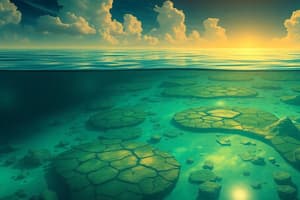Podcast
Questions and Answers
Explain how the upwelling of excess nutrients can lead to the formation of hypoxic zones.
Explain how the upwelling of excess nutrients can lead to the formation of hypoxic zones.
Upwelling brings excess nutrients to the surface, spurring algal blooms. When these blooms die, decomposition consumes oxygen, creating hypoxic conditions.
What is the primary difference between in-situ and ex-situ bioremediation, and why might one be preferred over the other in specific scenarios?
What is the primary difference between in-situ and ex-situ bioremediation, and why might one be preferred over the other in specific scenarios?
In-situ bioremediation treats contaminants at the site, while ex-situ involves removal for treatment elsewhere. In-situ is preferred when relocation isn't feasible, and ex-situ allows for more controlled conditions.
Describe the role of ASH TRACK Mobile App in fly ash management and its potential impact on environmental sustainability.
Describe the role of ASH TRACK Mobile App in fly ash management and its potential impact on environmental sustainability.
ASH TRACK connects fly ash producers (thermal plants) with potential users, promoting fly ash utilization in construction and other industries, This reduces environmental impact and promotes resource efficiency.
How do secondary pollutants differ from primary pollutants in origin and persistence? Give an example of each.
How do secondary pollutants differ from primary pollutants in origin and persistence? Give an example of each.
Explain the significance of distinguishing between quantitative and qualitative pollutants in environmental monitoring and regulation.
Explain the significance of distinguishing between quantitative and qualitative pollutants in environmental monitoring and regulation.
Contrast the environmental impacts of biodegradable and non-biodegradable pollutants, providing specific examples of each.
Contrast the environmental impacts of biodegradable and non-biodegradable pollutants, providing specific examples of each.
Differentiate between natural and anthropogenic sources of air pollution, illustrating each with a specific example.
Differentiate between natural and anthropogenic sources of air pollution, illustrating each with a specific example.
Describe the key differences between PM10 and PM2.5, including their sources and health impacts.
Describe the key differences between PM10 and PM2.5, including their sources and health impacts.
Explain the process of eutrophication, including the pollutants involved, the sequence of events, and the resulting environmental consequences.
Explain the process of eutrophication, including the pollutants involved, the sequence of events, and the resulting environmental consequences.
How do sediments act as water pollutants, and what are the primary sources contributing to their presence in water bodies?
How do sediments act as water pollutants, and what are the primary sources contributing to their presence in water bodies?
Describe the purpose and mechanisms of softening and aeration in secondary wastewater treatment.
Describe the purpose and mechanisms of softening and aeration in secondary wastewater treatment.
Explain the significance of the International Convention on Civil Liability for Bunker Oil Pollution Damage concerning marine environmental protection.
Explain the significance of the International Convention on Civil Liability for Bunker Oil Pollution Damage concerning marine environmental protection.
Discuss the environmental implications of heavy metal contamination in water, particularly concerning the sources and potential health effects associated with lead (Pb) and mercury (Hg).
Discuss the environmental implications of heavy metal contamination in water, particularly concerning the sources and potential health effects associated with lead (Pb) and mercury (Hg).
Explain the process of oil spill formation, what products can be released, and the specific mechanisms through which oil spills harm aquatic life.
Explain the process of oil spill formation, what products can be released, and the specific mechanisms through which oil spills harm aquatic life.
How are oil booms and floating barriers used in oil spill cleanup efforts, and are there circumstances where these methods might not be effective?
How are oil booms and floating barriers used in oil spill cleanup efforts, and are there circumstances where these methods might not be effective?
Describe the environmental hazards associated with 'acid mine drainage' and explain its formation.
Describe the environmental hazards associated with 'acid mine drainage' and explain its formation.
How are pathogens introduced into water systems, and what are the primary health concerns associated with pathogen-contaminated water?
How are pathogens introduced into water systems, and what are the primary health concerns associated with pathogen-contaminated water?
What is 'Mathemoglobinemia' and how is it related to agricultural pollution?
What is 'Mathemoglobinemia' and how is it related to agricultural pollution?
Explain the role of sorbents in oil spill cleanup.
Explain the role of sorbents in oil spill cleanup.
How is composting nature's recycling and what is it beneficial for?
How is composting nature's recycling and what is it beneficial for?
Describe the function of bioaugmentation.
Describe the function of bioaugmentation.
What is the use of vegetation to mitigate fluoride?
What is the use of vegetation to mitigate fluoride?
Explain how power plants are a source of water and air pollution.
Explain how power plants are a source of water and air pollution.
Why are organic pollutants of marine life?
Why are organic pollutants of marine life?
Outline the limitations natural sources have in managing modern water and air pollution?
Outline the limitations natural sources have in managing modern water and air pollution?
Flashcards
Dead Zones
Dead Zones
Areas in the ocean or large lakes with extremely low oxygen levels, insufficient to support most marine life.
Bioremediation
Bioremediation
The use of microorganisms (bacteria and fungi) to degrade environmental contaminants into less toxic forms.
In Situ Bioremediation
In Situ Bioremediation
Bioremediation done on-site, without removing the contaminated material.
Bioventing
Bioventing
Signup and view all the flashcards
Biosparging
Biosparging
Signup and view all the flashcards
Bioaugmentation
Bioaugmentation
Signup and view all the flashcards
Ex-Situ Bioremediation
Ex-Situ Bioremediation
Signup and view all the flashcards
Land farming
Land farming
Signup and view all the flashcards
Bioreactors
Bioreactors
Signup and view all the flashcards
Composting
Composting
Signup and view all the flashcards
Air Pollution
Air Pollution
Signup and view all the flashcards
Primary Pollutants
Primary Pollutants
Signup and view all the flashcards
Secondary Pollutants
Secondary Pollutants
Signup and view all the flashcards
Persistent Primary Pollutants
Persistent Primary Pollutants
Signup and view all the flashcards
Secondary Pollutants
Secondary Pollutants
Signup and view all the flashcards
Quantitative Pollutants
Quantitative Pollutants
Signup and view all the flashcards
Qualitative Pollutants
Qualitative Pollutants
Signup and view all the flashcards
Biodegradable Pollutants
Biodegradable Pollutants
Signup and view all the flashcards
Non-Biodegradable Pollutants
Non-Biodegradable Pollutants
Signup and view all the flashcards
Natural Air Pollutants
Natural Air Pollutants
Signup and view all the flashcards
Anthropogenic Air Pollutants
Anthropogenic Air Pollutants
Signup and view all the flashcards
Particulate Pollutants
Particulate Pollutants
Signup and view all the flashcards
Fly Ash
Fly Ash
Signup and view all the flashcards
Fluorides
Fluorides
Signup and view all the flashcards
Water Pollutants
Water Pollutants
Signup and view all the flashcards
Study Notes
- Dead Zones
- Dead zones are areas in the ocean with very low oxygen concentration (hypoxic conditions)
- They emerge when the influx of excess chemical nutrients spurs algae growth (algal blooms)
- Usually occur 200-800 meters below the surface (in the saltwater layer)
- Hypoxic zones can occur naturally due to the upwelling of excess nutrients
- They can be created or enhanced by human activity
- Dead zones are detrimental to animal life and most of the animal life either dies or migrates from the zone
How Dead Zones Form
-
Fertilizers, sewage, and nutrients from farming flow down rivers into the water
-
Nutrients stimulate massive growth of algae blooms
-
Plankton and algae die, sink to the bottom, and decompose using up oxygen in the water
-
Area becomes starved of oxygen; fish avoid the area
-
Bioremediation
- Uses microorganisms (bacteria and fungi) to degrade environmental contaminants into less toxic forms
- Microorganisms can be specifically designed for bioremediation using genetic engineering techniques
- Can be performed in situ (at the site) or ex situ (involves the removal of contaminated material to be treated elsewhere)
In Situ Bioremediation
- Bioventing: Supply of nutrients through wells to contaminated soil to stimulate the growth of bacteria
- Biosparging: Injection of air under pressure below the water table to increase groundwater oxygen concentrations and enhance the rate of biological degradation of contaminants by bacteria
- Bioaugmentation: Microorganisms are imported to a contaminated site to enhance the degradation process
Ex Situ Bioremediation
-
Land farming: Contaminated soil is excavated and spread over a prepared bed, and periodically tilled until pollutants are degraded to stimulate indigenous biodegradative microorganisms and facilitate their aerobic degradation of contaminants
-
Bioreactors: These involve the processing of contaminated solid material (soil, sediment, sludge) or water through an engineered containment system
-
Composting: a process using nature’s recycling of decomposed organic materials into a soil known as compost
-
Air Pollution
- Refers to undesirable changes in the physical and chemical constituents of air due to human activities
Air Pollutants Based on Source
- Primary: Direct emission into the atmosphere
- Examples: CO, SO₂, NOx, PM
- Secondary: Reaction with atmospheric pollutants
- Examples: Ozone, PAN
Air Pollutants Based on Mode of Release
- Indoor
- Examples: Cooking, smoking, air conditioning
- Examples of pollutants: CO, CO₂, VOCs
- Outdoor: Industrial processes, transportation
- Examples of pollutants: PM, CO, VOCs
Air Pollutants Based on Chemical Composition
- Particulate Matter: Solid or liquid aerosols
- Examples: PM2.5, PM10
- Gaseous: Miscible with air in vaporous form
- Examples: SOx, Ozone, NOx, CO
Air Pollutants Based on Persistence
- Primary Pollutants: Persist in the form in which they are added to the environment
- Examples: DDT, plastic
- Secondary Pollutants: Formed by interaction among the primary pollutants
- PAN (Peroxyacetyl Nitrate, formed by interaction of Nitrogen Oxides and Hydrocarbons)
Air Pollutants Based on Existence in Nature
- Quantitative Pollutants: Occur in nature and become pollutants when concentration reaches beyond a threshold level
- Examples: Carbon Dioxide, Nitrogen Oxide
- Qualitative Pollutants: Man-made, do not occur in nature
- Examples: Fungicides, herbicides, DDT
Air Pollutants Based on Biodegradability
- Biodegradable Pollutants: Waste products degraded by natural process of microbial action
- Example: sewage
- Non-Biodegradable Pollutants: Pollutants which don't decompose naturally or decompose slowly
- Examples: plastics, polythene bags, DDT
Air Pollutants Based on Origin
- Natural: Released during natural processes
- Examples: volcanic eruptions, forest fires, grass fires
- Anthropogenic: Released during anthropogenic activities
- Examples: CO₂ emissions from the burning of fossil fuels
Sources of Air Pollution
-
Natural Sources: Ash from burning volcanoes, dust from storms, forest fires, pollen grains from flowers in air
-
Human Sources: Power stations using coal or crude oil release CO₂, furnaces using coal, cattle dung cakes, firewood, kerosene. Steam engines such as railways, steamers, motor vehicles give out CO₂
- Also include motor and internal combustion engines, vegetable oils, and pesticide residues
-
Particulate Pollutants
- Matter suspended in air such as dust and soot
- Major sources are from industries, vehicles, power plants, construction activities, oil refineries, railway yards, marketplaces
- PM10: Inhalable particles with diameters generally 10 micrometers and smaller derived from dust stirred up from construction sites, pollen, emissions from vehicles and industrial processes
- PM2.5: Fine inhalable particles, with diameters generally 2.5 micrometers and smaller derived from combustion processes
Fly Ash
- End product of combustion during power generation in coal-based thermal power plants
- Composed of silica, alumina, oxides of iron, calcium, magnesium, and toxic heavy metals
- Used in manufacturing of Portland Cement, bricks/blocks/tiles, road embankment construction and low-lying area development
Fluorides
- From sources such as aluminum, steel and electrochemical plants, blast furnaces, brick kilns, coal combustion, tile and glass etching factories.
- Volcanoes also release fluorides
- Impact: Fluoride particles settle on vegetation, burn tips of leaves and when cattle eat the vegetation they suffer from fluorosis resulting in loss of teeth, weight, and lameness
Water Pollutants
- Pathogens: Sewage, human and animal wastes leading to depletion of dissolved oxygen in water
- Organic pollutants: Oil & grease, pesticides/weedicides, plastics, detergents disrupt marine life and are sometimes toxic
- Inorganic pollutants: Fertilizers like phosphates and nitrates that lead to eutrophication; Acids and alkalies from mine drainage that kill freshwater organisms
- Radioactive materials: Can lead to cancer and genetic defects
- Heat: Decreases oxygen solubility
- Sediments: affects water quality
Water Pollution Control Measures
- When wastewater is dumped off into rivers, treatment is carried out by sedimentation, coagulation and filtration, known as primary treatment.
- When water is needed for drinking, it undergoes further treatments named as secondary and tertiary treatments.
Primary Treatment
- Sedimentation: Polluted water sits to settle silt, clay and other matter.
- Coagulation: Combines fine particles and colloidal suspensions into large particles called coagulation using coagulants such as potash alum.
- Filtration: Filters suspended particles, flocculants, bacteria, and other organisms. Impurities collected are called sludge.
Secondary Treatment
- Calcium and magnesium cations are removed from hard waters.
- Soft water is exposed to air to encourage bacterial decomposition into harmless products.
Tertiary Treatment
- Chlorine is used as a disinfectant, using methods such as ultraviolet radiation or ozone gas treatment
Sources of Water Pollution
- Community Waste Water: Includes discharges from houses, commercial and industrial establishments, consisting of human excreta, food residues, cleaning agents, detergents and other wastes
- Industrial Waste: Discharges several inorganic and organic pollutants
Types of Industries/Pollutants
- Example Mine Wastes: Chlorides, various metals, ferrous sulphate, sulphuric acid, hydrogen sulphide, ferric hydroxide, surface wash offs, suspended solids, chlorides and heavy metals
- Example Soap and Detergent: Tertiary ammonium compounds alkalies
- Paper and Pulp: Sulphides, bleaching liquors
Oil Spills
- Refers to any uncontrolled release of crude oil, gasoline, fuel or other oil by products into the atmosphere causing major environment harm
- Oil toxicity components may cause serious health problem like heart damage
- To clean Oil spills, floating barriers are used to prevent it dispersing.
Agricultural Sources of Water Pollution
- Fertilizers
- Pesticides
- Animal Excreta
- Excess nitrate in drinking water reacting to form a non-functional compound impairing oxygen transport, know as mathemoglobinemia or blue baby syndrome
- Thermal Pollution reduces the amount of dissolved oxygen
- Marine Pollution caused by cities and navigational discharge
Heavy Metals (Ions) In the Water
- Copper pollutants can come from fertilizers
- Zinc pollutants can come from solders and cosmetics
- Chromium pollutants can come from the leather industry
- Mercury pollutants can come from coal combustion
- Lead pollutants can come from PVC pipes
Studying That Suits You
Use AI to generate personalized quizzes and flashcards to suit your learning preferences.




